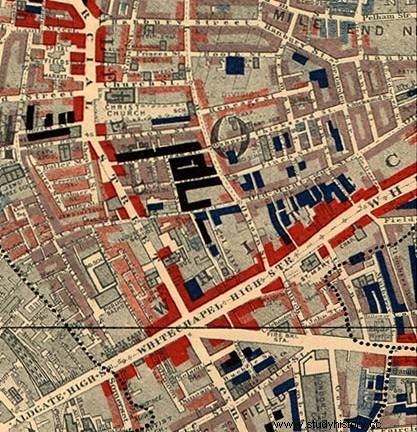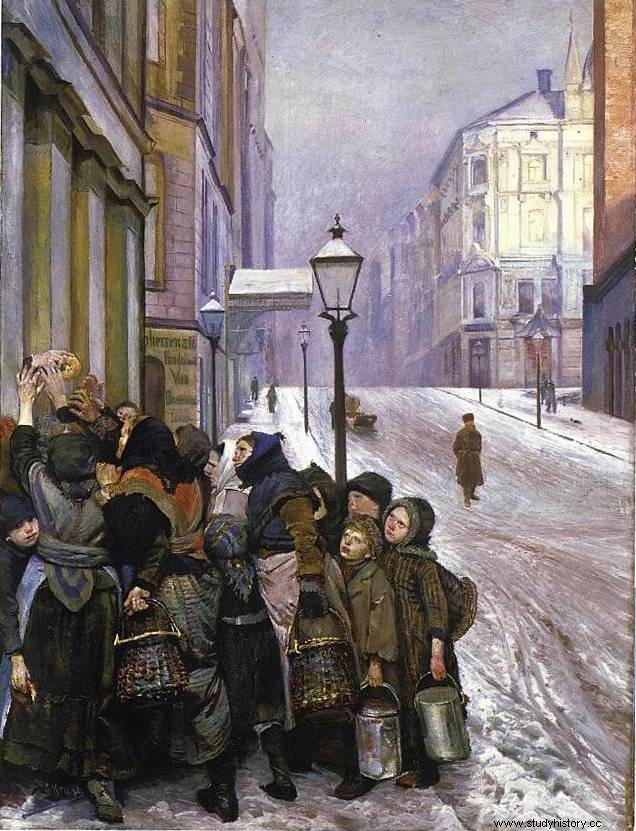At the end of the 19th century, Great Britain was the most powerful power in the world, and London was the largest metropolis in the world. The Empire ruled and prosperous, but in the streets of its capital, people were starving. The poverty of London's poor is hard to believe.
In 1900, London had a population of 6.7 million. Railway, electricity, efficient sewage system, subway, telegraphs, telephones, cars, buses, cinemas, elegant department stores appeared in the city ... The population grew by over 5 million over the course of a century, the area and buildings also grew rapidly.
London in the 19th century was also the richest metropolis in the world. Only that unimaginable wealth was adjacent to him unimaginable poverty. While the royal family, aristocracy, industrialists and merchants were abundant in wealth and money, in the neighborhoods of poverty, millions were starving, suffering from cold and disease.
As we read in the book by Krystyna Kaplan entitled "London in the days of Sherlock Holmes" at the turn of the 19th and 20th centuries as many as one third of the inhabitants of the capital of the empire lived in extreme poverty.
4 million poor
It really could be even worse! British social activist and sociologist Charles Booth, who documented the everyday life and work of Londoners, in 1889 drew up a map of the poverty of the capital. Areas where people have vegetated very poor, part-time workers, with chronic deprivation he marked in dark blue.
Places occupied by low class, idlers, criminals and half criminals marked in black. In turn, areas inhabited by the middle and upper classes are marked in red. A glance at Booth's map shows that in many parts of the "richest metropolis in the world" navy blue and black are dominant. In turn, a more detailed map showed as many as 134 regions of poverty with "about 30,000 inhabitants each."

Districts in extreme poverty are marked in black and navy blue. Charles Booth, "Poverty Map" (source:public domain).
This was a total of over 4 million poor. A staggering number for the conditions of the epoch. In 1900, Warsaw, Gdańsk, Kraków, Poznań, Łódź, Lviv and Vilnius together had just over 1.5 million inhabitants. And in London, there were only two and a half times more poor!
Floats and scum
So much for Booth's analysis. However, the vivid description contained in one of the novels of the careful observer of the nineteenth-century English reality Charles Dickens will appeal to us more. This author wrote about the London slums in "Olivier TWI":
Close to this section of the Thames where it rises, right on the river is the Rotherhithe Church, where the coast buildings are dirtiest and the ships on the river blackest with coal dust and fumes of the crowded low houses, it houses the meanest, strangest, most unusual of the many neighborhoods that London hides.
To get to this place, the stranger must pass through a maze of stuffy, narrow, muddy streets. A crowd of the most vulgar and at the same time the poorest people from the river (...). Jumping among the lowest-class unemployed workers, ship porters, street coal thieves, shameless women, ragged children and all kinds of river scum and scum - the newcomer struggles to make his way.
Odd sights and smells hit him from the narrow alleys going left and right, he is deafened by the rattle of heavily loaded carts carrying huge piles of goods from the warehouses that rise on each corner.
Death by starvation
There have been times when people have starved to death in the streets of London. Perhaps one of my readers remembers the unfortunate young man who wrote in chalk the words "I'm starving" on the footbridge near the Waterloo Bridge on the Surrey side.
He lay curled up in a pile of misfortune and seemed dead from cold and misery. Through the holes in the cotton jacket, he could see the shirtless neck and shoulders. He had no shoes or stockings - wrote another researcher of London poverty, Henry Mayhew.

Hunger and poverty were part of the daily life of Europe. Christian Krohg, "Fighting for Survival" (Source:Public Domain).
The streets of London were crowded with ragged children , stealing, begging, trading, or trying to find something to eat. Many of them were either abandoned by their parents or expelled from the artisanal workshops where they were supposed to learn their trade.
They still walked around half-naked or in ragged rags and harassed names and curses at each other , rolled in the street dirt or stole in the harbor and on the wharfs - reported the witness. Some street children ended up in shelters run by parishes. They were given a roof over their heads and poor food, but had to work hard in return.
From seven in the morning to six in the evening, they weaved wool or linen cloth or knitted stockings. They were also used for cleaning. It was common to loan their wards to entrepreneurs as cheap labor for factories. The workhouses were dirty and cramped and the staff tended to be brutal and soulless.
Beating and humiliation was the order of the day. Flogging was punished for disobedience. The unruly boy was tied to a table or to specially prepared ropes on the wall in front of everyone, and then severely beaten. After the whipping, the unconscious victim was usually handed over to the nurse.
A four-year-old for 20 shillings
Brutal caregivers are a pain, but what about parents who sell their children? It happened that drunk or very poor parents gave four-year-old boys to the deadline for 20-30 shillings.
Chimney sweeps bought them willingly, because little boys, due to their small stature, were perfect for cleaning long and narrow London chimneys. Those who did not want to delve into dark and dirty interiors were pricked with pins or burned with fire.
The work was excruciatingly hard, and there were also cases of asphyxiation of boys who got stuck in the chimneys. Chimney sweeps rarely get it wrong, they walked around smothered all the time and often fell ill. Due to the specific working conditions, many of them became disabled at a young age.

Chimney sweepers rarely make mistakes, they walked around smothered all the time and often fell ill with various diseases. Paul-Charles Chocarne-Moreau, "Opportunity Makes a Thief" (Source:Public Domain).
The number of all children employed to work in the street was estimated at between 10,000 and 30,000! No investment today gives a better return on capital than employing children from poor families - Written in 1892. Those children who did not end up in shelters were organized by gangs dealing with shoplifting, pickpocketing and robbing drunkards.
Charlie Chaplin in the workhouse
Adults were also sent to shelters called Nursing Homes or Homes for the Poor. Theoretically, these places were supposed to provide them with a dignified stay, shelter and meals. In practice they turned into small concentration camps or labor camps. The charges were separated from their families, their clothes were removed, they were examined, bathed, and they were assigned a status band (e.g. yellow - unmarried, pregnant woman).
During their stay, they had to work:men crushed stones or bones, women untangled ropes into single threads, cleaned, washed and cooked. The work was unpaid, and for evading a meal, or thrown into prison and sentenced to heavy labor. There was frequent harassment, beatings and harassment by staff.
The future actor and director Charlie Chaplin passed through such a poorhouse in 1896 in London with his mother and brother. He later used the experience of poverty in his films made in the USA.
They owe each other
Where did such large and so drastic areas of poverty in the richest city in the world come from? London - like every metropolis - attracted the inhabitants of the provinces who flocked to the capital in search of a better life. They were occupied in numerous factories, enterprises and companies there.
It was enough, however, that the winter was cold for dockers, construction workers or employees of transport companies to be unceremoniously fired from their jobs.
Any economic downturn or economic troubles had a similar effect. The sick, disabled and people too old to work were also left without a livelihood. Add to that their families and newcomers constantly flocking to the city, and we will have the millions of poor people living in 19th century London.
In addition, in keeping with the Protestant spirit, many better-off people believed that the poor were to blame for themselves. They fell into poverty because of laziness and a lack of willingness to work ...

Begging children were nothing strange at the turn of the 19th and 20th centuries. Few showed empathy. Paul Charles Chocarne-Moreau, "Mercy" (source:public domain).
***
At the turn of the 19th and 20th centuries, London was the capital of the largest and richest empire in the history of the world. He has become an arena for material, intellectual and moral progress. There are photography and "moving pictures", "horseless carriages" and a subway powered by steam that "smells like the breath of a crocodile." However, the city also has its dark side. Jack the Ripper is roaming the gloomy district of Whitechapel. A certain Dr. Crippen vaguely tells about the sudden disappearance of his wife. When the police make the gruesome discovery, he'll be on a ship to Canada. His fate will be decided by a new invention - a telegraph.
In a tenement house at 221B Baker Street, the most famous detective in the world:Sherlock Holmes, sitting in an armchair puffing his pipe. When he dies, men wear black armbands, women wear black veils. London's mourning continues so long that Conan Doyle is forced to resurrect his hero.
Interested in Victorian London? Reach for the latest book by Krystyna Kaplan, entitled "London in the days of Sherlock Holmes" (Polish Scientific Publishers PWN).
Bibliography:
- Krystyna Kaplan, London in the time of Sherlock Holmes , PWN Publishing House, Warsaw 2016
- Peter Ackroyd, London. Biography , Zysk i Ska Publishing House, Poznań 2011
- Charles Dickens, Oliver Twist , Wydawnictwo Zielona Sowa, Krakow 2005
